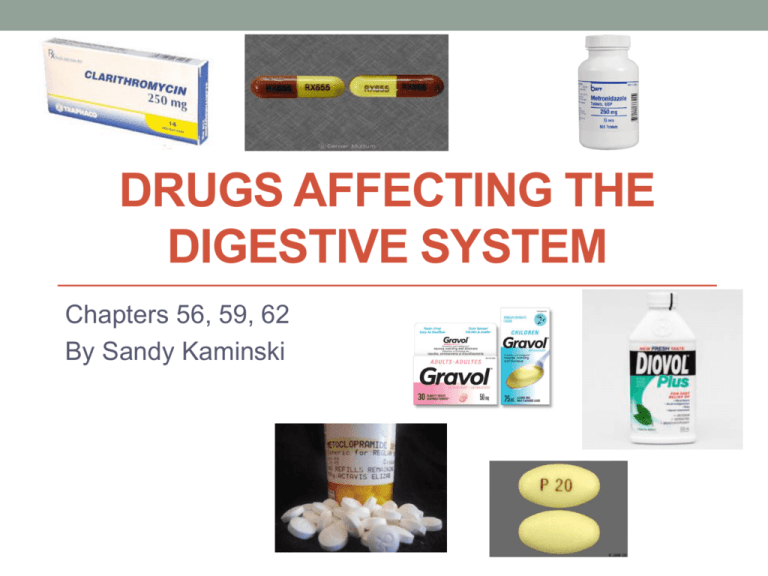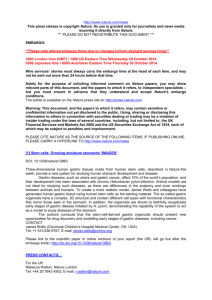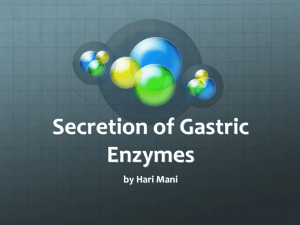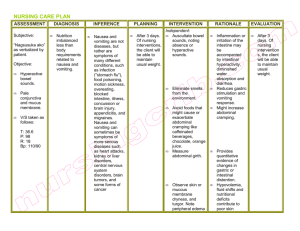My PP on GI drugs
advertisement

DRUGS AFFECTING THE DIGESTIVE SYSTEM Chapters 56, 59, 62 By Sandy Kaminski Chapter 56: Physiology of the Digestive System The organs of the digestive system • • • • • • • • Oral cavity Esophagus Stomach Small intestine Large intestine Pancreas Gallbladder Liver The Main Function of the GI System - To provide the body with fluids, nutrients, and electrolytes in forms that can be used at the cellular level. - The system also disposes of waste products that result from the digestive process. • Saliva • Gastric Juices • • • • mucus digestive enzymes hydrochloric acid Electrolytes • Pancreatic juices • amylase • lipase • trypsin and chymotrypsin • Bile Effects of Drugs on the Digestive System • To relieve symptoms and disorders of the digestive system • To alter the digestive system secretion, absorption, or motility • Drugs used may also cause digestive symptoms • ie, nausea, vomiting, constipation, diarrhea, abdominal pain Questions: The major digestive enzyme in gastric juice is pancreatase. • F. The major digestive enzyme in gastric juice is pepsin, a proteolytic enzyme. The parasympathetic nervous system increases motility and secretions. •T Blood flow increases during digestion, absorption, and parasympathetic stimulation •T Questions • The sympathetic nervous •F system (fight or flight) increase gastric motility and secretions. • The GI secretions can break down medications so they can be absorbed or they may destroy the medications. •T Chapter 59: Drugs Used for Peptic Ulcer (PUD) and Acid Reflux Disorders (GERD) H.Pylori Agents (Antibiotics) Antacids Proton-pump Inhibitors Peptic Ulcer Disease (PUD) • Attributed to an imbalance between cell-destructive and cell-protective effects • Such as • gastric acid • Pepsin • H. pylori infection • NSAIDs • Stress • Cigarette smoking PUD • Gastric Acid • secreted by parietal cells in the mucosa of the stomach antrum, near the pylorus • Dissolve food • Act as a bactericide • Convert pepsinogen to pepsin • Pepsin • A proteolytic enzyme that helps digest protein but can also digest the stomach wall • Proton-pump system catalyzes the production of gastric acid and acts as a gastric acid (proton) pump to move gastric acid from parietal cells in the mucosal lining of the stomach into the stomach lumen. PUD • Helicobacter pylori (H. pylori) • Bacterium found in GI tract of 75% in those with gastric ulcers and more than 90% in those with duodenal ulcers • It colonizes the mucus-secreting epithelial cells of the stomach mucosa and is thought to produce gastritis and ulceration by impairing mucosal function. Antibiotics are used to eradicate H. pylori amoxicillin, clarithromycin, metronidazole, tetracycline • Cell-protective effects • secretion of mucus and bicarbonate • dilution of gastric acid by food and secretions • prevention of diffusion of hydrochloric acid from the stomach lumen back into the gastric mucosal lining • the presence of prostaglandin E • alkalinization of gastric secretions by pancreatic juices and bile Gastroesophageal Reflux Disease (GERD) • Most common disorder of the esophagus • Regurgitation of gastric contents (gastric acid and pepsin) into esophagus • Main cause is incompetent lower esophageal sphincter (LES) • Main symptoms – heartburn and pain on swallowing Risk factors that contribute to impaired contraction of the LES include • foods (eg, fats, chocolate) • fluids (eg, alcohol, caffeinated beverages) • medications (eg, estrogens, progesterone, beta-agonists, anti- • • • • • cholinergics, calcium channel blockers, narcotics, nitrates) gastric distension cigarette smoking recumbent posture Obesity Pregnancy What can PUD and GERD lead to? • PUD • Bleeding • Perforation • Obstructions • GERD • Barrett’s esophagus • Tissue lining changes and resembles that of instestine • 30 to 125 times more likely to develop esophageal cancer • Esophageal cancer • Laryngeal cancer • Erosive esophagitis • Esophageal strictures Antacids Alkaline substances that neutralize acids Raising the pH to approximately 3.5 neutralizes more than 90% of gastric acid and iinhibits conversion of pepsinogen to pepsin Commonly used antacids are aluminum, magnesium, and calcium compounds Used to treat PUD, GERD, esophagitis, heartburn, gastritis, GI bleeding, stress ulcers Antacids: Drug Interactions • Most often they decrease the absorption of other medications by the process of chelation • Chelation • Chemical binding, or inactivation, of another drug • Produces insoluble complexes • Result: reduced drug absorption • also affect the absorption of some nutrients. • Dietary folate, Fe, Ca, and Vit B12 are better absorbed in acidic environment and therefore deficiencies may occur. Antacids: Nursing Implications • Assess for allergies • Preexisting conditions that may restrict the use of antacids include • Electrolyte imbalances • Renal disease • DM • Pregnancy • GI obstruction • HF Histamine2 Receptor Antagonists (H2RAs) Histamine causes strong stimulation of gastric acid secretion H2RAs inhibit both basal secretion of gastric acid and secretion stimulated by histamine, acetylcholine, and gastrin Decrease amount, acidity, and pepsin content of gastric juices Cimetidine, ranitidine (Zantac), famotidine are available H2RAs H2 Antagonists: Nursing Implications • Assess for allergies and impaired renal or liver function • Dose must be reduced in renal impairment • Use with caution in clients who are confused, disoriented, or elderly • Take 1 hour before or after antacids • Available in both OTC and Rx preparations • For intravenous doses • follow administration guidelines Proton Pump Inhibitors (PPIs) • Strong inhibitors of gastric acid secretion • Bind irreversibly to the gastrin proton pump to prevent release of gastric acid from parietal cells thereby blocking final step of acid production • Suppress gastric acid secretion from parietal cells in response to all primary stimuli (histamine, gastrin, and acetylcholine) • Available preparations: • Omeprazole, esomeprazole, lansoprazole, pantoprazole, and rabeprazole Proton Pump Inhibitors: Nursing Implications • Assess for allergies and history of liver disease • Pantoprazole is available for parenteral administration, and can be used for clients who are unable to take oral medications • Safe for short-term therapy • Use cautiously in those with severe liver impairment • Lansoprazole and rabeprazole Helicobacter Pylori Agents • Recommended treatment includes • Two or three antimicrobials • Amoxicillin, clarithromycin, metronidazole, tetracycline • Single agent not used b/c of concern about emergence of drug-resistant H. pylori • PPI or H2RA • PPI = proton-pump inhibitor • H2RA = Histamine 2 Receptor Antagonists • Accelerates symptom relief and healing of the ulcer Questions: • Risk factors for PUD include stress, NSAID ingestion, Helicobacter pylori infection, and cigarette smoking. • Prostaglandin E and mucus are cell- protecting effects that protect the wall from injury. • GERD is thought to be the result of an incompetent upper esophageal sphincter. •T •T •F - lower esophageal sphincter Chapter 62: Anti-Emetics Definitions • Nausea: unpleasant sensation of abd discomfort accompanied by a desire to vomit. May occur without vomiting. • Vomiting: expulsion of stomach contents through the mouth, May occur without prior nausea. • Occurs when the vomiting centre (VC) or chemoreceptor trigger zone (CTZ) are stimulated Causes of N/V in hospital • Gastrointestinal disorders • including infection or inflammation in the GI tract, liver, gall-bladder, or pancreas • impaired GI motility and muscle tone (eg, gastroparesis) • overeating or ingestion of foods or fluids that irritate the GI mucosa • Cardiovascular, infectious, neurologic, or metabolic • • • • • • disorders Drug therapy Pain and other noxious stimuli Emotional disturbances; physical or mental stress Radiation therapy Motion sickness Post-operative status Mechanism of Action of Anti-Emetics • blocking one of the vomiting pathways, thus blocking the stimulus that induces vomiting • several different therapeutic classifications • anti-cholinergic • anti-dopaminergic • anti-histaminic • anti- serotonergic effects • more effective in prophylaxis than treatment • Eg. Administering Morphine IV with Gravol IV • Eg. Taking anti-motion meds 30 minutes prior to getting on the boat!! CTZ – Chemoreceptor Trigger Zone Classifications of Anti-emetics – all lumped into anti-cholinergics / anti-dopminergics/ anti-histaminic/anti-serononergic 1. Phenothiazines • Block dopamine from receptor sites in brain and CTZ • (chemoreceptor trigger zone) • chlorpromazine (Largactil) is the prototype • prochlorperazine (Stemetil) • CNS depressant – therefore causes sedation • Effective for n/v induced by drugs and radiation therapy • Not effective for motion sickness 2. Anti-histamines • block action of acetylcholine in brain (anti-cholinergic effects) • Dimenhydrinate (Gravol) and meclizine (Bonamine) • effective in treating motion sickness Classifications of Anti-emetics – all lumped into anti-cholinergics / anti-dopminergics / anti-histaminic / anti-serononergic 3. Corticosteriods • Block prostaglandin activity in the cerebral cortex • Dexamethasone (Decadron) • Commonly used in the management of chemotherapy-induced emesis and intra-operatively • Causes euphoria, insomnia 4. Benzodiazapines • Produce relaxation and inhibit cerebral cortex input to vomiting center • lorazepam (Ativan) • Anticipatory chemotherapy induced n/v Classifications of Anti-emetics – all lumped into anti-cholinergics / anti-dopminergics/ anti-histaminic/anti-serononergic 5. Prokinetic Agents • Increase the release of Ach from the GI tract • metoclopramide (Maxeran) • Increases GI motility • Used in gastroparesis (gastric retention of foods) • May increase the effects of alcohol 6. 5-Hydroxytryptamine 3 (5-HT3 or Serotonin Receptor Antagonists) • Antagonize serotonin receptors • ondansetron (Zofran) • Moderate to severe n/v (cancer therapy, post-op) • May cause diarrhea, headache, muscle aches, elevated liver enzymes What’s important for me to know about anti-emetics? • Drug selection, dose and route depend on the cause of the nausea/vomiting • Most adverse affects are sedation, drowsiness, dry mouth, diarrhea or constipation, and headache • Multi-drug regimens may be used to treat n/v • Use in special populations should be considered • Eg. Older adults – increased sedative effects • Eg. Scopolamine not recommended in pediatric population • Eg. Metoclopramide doses should be reduced in renal failure patients What’s important for me to know about anti-emetics? • Antiemetics have anticholinergic, antidopaminergic, antihistaminic, or antiserotonergic effects. Most exert an effect on the vomiting center, CTZ, cerebral cortex, vestibular apparatus, or a combination of these areas • Pretreatment is usually most effective • 5-HT3 receptor antagonists like ondansetron are usually considered the most effective antiemetics. Question – T or F • The benzodiazapine antianxiety drugs are used as anti- emetics in multidrug regimens to prevent nausea and vomiting associated with chemotherapy. True!








